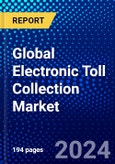The Global Electronic Toll Collection Market is estimated to be USD 9.09 Bn in 2023 and is expected to reach USD 13.15 Bn by 2028 growing at a CAGR of 7.66%.To streamline traffic at the various toll stations the demand for electronic toll collection is increasing
Market Dynamics
Market dynamics are forces that impact the prices and behaviors of the stakeholders. These forces create pricing signals which result from the changes in the supply and demand curves for a given product or service. Forces of Market Dynamics may be related to macro-economic and micro-economic factors. There are dynamic market forces other than price, demand, and supply. Human emotions can also drive decisions, influence the market, and create price signals.As the market dynamics impact the supply and demand curves, decision-makers aim to determine the best way to use various financial tools to stem various strategies for speeding the growth and reducing the risks.
Market Segmentations
- The Global Electronic Toll Collection Market is segmented based on Offering, Technology, Operation, Applications, and Geography.
- By Offering, the market is classified into Hardware, Service, and Software..
- By Technology, the market is classified into Radio-Frequency Identification (RFID), Dedicated Short-Range Communication (DSRC), and Other Technologies.
- By Operation, the market is classified into Dynamic Tolling, Integrated Open Road Tolling with Existing Toll Facilities, Mileage-Based User Fees, Open Road Tolling, and Video Tolling.
- By Applications, the market is classified into Highways and Urban Areas.
- By Geography, the market is classified into Americas, Europe, Middle-East & Africa, and Asia-Pacific.
Company Profiles
The report provides a detailed analysis of the competitors in the market. It covers the financial performance analysis for the publicly listed companies in the market. The report also offers detailed information on the companies' recent development and competitive scenario. Some of the companies covered in this report are Kapsch TrafficCom AG, Conduent Business Services, LLC, Efkon GmbH, Transcore, Thales Group, etc.Countries Studied
- America (Argentina, Brazil, Canada, Chile, Colombia, Mexico, Peru, United States, Rest of Americas)
- Europe (Austria, Belgium, Denmark, Finland, France, Germany, Italy, Netherlands, Norway, Poland, Russia, Spain, Sweden, Switzerland, United Kingdom, Rest of Europe)
- Middle-East and Africa (Egypt, Israel, Qatar, Saudi Arabia, South Africa, United Arab Emirates, Rest of MEA)
- Asia-Pacific (Australia, Bangladesh, China, India, Indonesia, Japan, Malaysia, Philippines, Singapore, South Korea, Sri Lanka, Thailand, Taiwan, Rest of Asia-Pacific)
Competitive Quadrant
The report includes Competitive Quadrant, a proprietary tool to analyze and evaluate the position of companies based on their Industry Position score and Market Performance score. The tool uses various factors for categorizing the players into four categories. Some of these factors considered for analysis are financial performance over the last 3 years, growth strategies, innovation score, new product launches, investments, growth in market share, etc.Ansoff Analysis
- The report presents a detailed Ansoff matrix analysis for the Global Electronic Toll Collection Market. Ansoff Matrix, also known as Product/Market Expansion Grid, is a strategic tool used to design strategies for the growth of the company. The matrix can be used to evaluate approaches in four strategies viz. Market Development, Market Penetration, Product Development, and Diversification. The matrix is also used for risk analysis to understand the risk involved with each approach.
- The publisher analyses the Global Electronic Toll Collection Market using the Ansoff Matrix to provide the best approaches a company can take to improve its market position.
- Based on the SWOT analysis conducted on the industry and industry players, the publisher has devised suitable strategies for market growth.
Why buy this report?
- The report offers a comprehensive evaluation of the Global Electronic Toll Collection Market. The report includes in-depth qualitative analysis, verifiable data from authentic sources, and projections about market size. The projections are calculated using proven research methodologies.
- The report has been compiled through extensive primary and secondary research. The primary research is done through interviews, surveys, and observation of renowned personnel in the industry.
- The report includes an in-depth market analysis using Porter's 5 forces model, PESTLE Analysis, and the Ansoff Matrix. In addition, the impact of COVID-19 and the impact of economic slowdown & impending recession on the market are also featured in the report.
Table of Contents
1 Report Description
2 Research Methodology
3 Executive Summary
4 Market Dynamics
5 Market Analysis
6 Global Electronic Toll Collection Market, By Offerings
7 Global Electronic Toll Collection Market, By Technology
8 Global Electronic Toll Collection Market, By Operation
9 Global Electronic Toll Collection Market, By Applications
10 Americas' Electronic Toll Collection Market
11 Europe's Electronic Toll Collection Market
12 Middle East and Africa's Electronic Toll Collection Market
13 APAC's Electronic Toll Collection Market
14 Competitive Landscape
15 Company Profiles
16 Appendix
Companies Mentioned
- Abertis Infraestructuras SA
- Arh Inc.
- Conduent Business Services, LLC
- Cubic Corp.
- Efkon GmbH
- Electronic Transaction Consultants Corp.
- Feig Electronics GmbH
- Jenoptik Ag
- Kapsch TrafficCom Ag
- Mitsubishi Heavy Industries, Ltd.
- Neology, Inc.
- Perceptics, LLC
- Quarterhill Inc.
- Siemens
- Star Systems International Ltd.
- Tecsidel, SA
- Thales Group
- Toshiba Corp.
- Transcore
- Vinci SA
Table Information
| Report Attribute | Details |
|---|---|
| No. of Pages | 194 |
| Published | February 2024 |
| Forecast Period | 2023 - 2028 |
| Estimated Market Value ( USD | $ 9.09 Billion |
| Forecasted Market Value ( USD | $ 13.15 Billion |
| Compound Annual Growth Rate | 7.6% |
| Regions Covered | Global |
| No. of Companies Mentioned | 20 |









